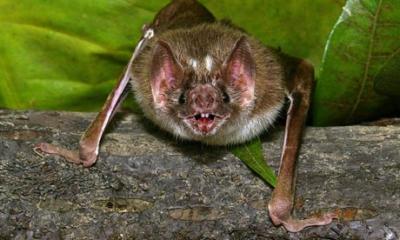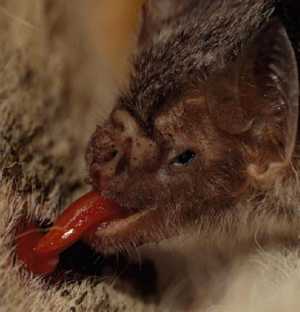 Vampire Bat Vampire BatDesmodus
rotundus [dez mO' duhs rO' tun duhs]
Description
Vampire bats are 2.75 to 3.5
inches long, have a wingspan of 13.75 to 15.75
inches, and weigh 0.5 to 1.75 ounces; females are
larger than males.
Well adapted for its lifestyle,
the vampire bat has very sharp triangular-shaped
front teeth, which cut like a razor. Its
esophagus is short and narrow, and will permit
nothing but fluids to pass. Two lateral grooves
in the tongue expand and contract as the animal
feeds. It also has an acute sense of smell and
large eyes, allowing it find prey easily.
Unlike other bats, vampire bats
can walk, run, and hop along the ground. They can
also jump forward, backward, and laterally,
allowing them to easily avoid kicking hooves,
swishing tails, other predators, etc. Jumping is
also used to initiate flight, especially after a
large meal.
 Distribution and Habitat Distribution and Habitat
The common vampire bat ranges
from Mexico to Argentina and Chile. It lives in
moderately lighted caves with deep fissures, tree
hollows, old wells, mine shafts, and abandoned
buildings.
 Habits and Behaviors Habits and Behaviors
Vampire bats live in colonies
ranging from 20 to 100 animals; much larger
colonies, up to 5,000, have been reported.
A vampire bat usually walks or hops up to its
prey, then climbs up the animal and finds a
suitable meal site. Once found, it makes a small
incision in the skin, and then laps up the blood
as it oozes from the wound. The bite itself is
relatively painless, and it is not uncommon for
an animal to be fed upon while sleeping and not
even stir. Many bats do, however, carry rabies
and other parasites, and occasionally a bite will
become infected. In the wild, vampire bats tend
to prey upon livestock because of availability.
They will, on rare occasions, also prey on
humans.
Reproduction
Males compete for space in
roosting places containing females, and each male
defends his own small part of the roost from
other males through chasing, pushing, and
sometimes fighting. Although females may give
birth any time of the year, births tend to peak
in April and May and again in October and
November. Typically only one young is born at a
time, but twins are not uncommon.
Vampire bats can live up to 12
years in the wild.
Scientific
Classification
phylum Chordata
subphylum Vertebrata
class Mammalia
order Chiroptera
family Phyllostomidae
subfamily Desmodontinae
genus & species Desmodus rotundus

Animal Diversity Web http://animaldiversity.org/accounts/Desmodus_rotundus/
Questions or comments about
this page?
|



